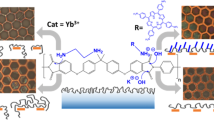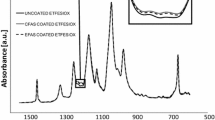Abstract
Three different hydroxyl functional propylene/10-undecen-1-ol (PP-OH) copolymers were attached photochemically to a photoreactive benzophenone derivative that was bound to SiO2 surfaces via a silane anchor. As a result of the photochemical reaction, thin layers of the PP-OH polymers were covalently bound to the surface. The thickness of the layers was a function of the molecular weight of the polymer. Poly(2-hydroxyethymethacrylate) (PHEMA) nanolayers were successfully grafted onto the PP-OH-modified silicon wafers (PP-OHMSW) via surface-initiated atom-transfer radical polymerization (ATRP) in aqueous media at ambient temperature. Kinetic studies revealed an increase in thickness with reaction time, indicating that the polymerization process has some “living” character. Contact angle measurements showed a reduction in the water contact angles of the resulting PP-OHMSW-PHEMAs, indicating a more hydrophilic surface tension state. The coupling of ATRP initiator to the hydroxyl groups on the PP-OH polymers, the surface-initiated ATRP, and the grafting of PHEMA onto the PP-OHMSW were confirmed by Fourier transform infrared spectroscopy (FT-IR). The grafted polymeric layers provide a platform for further surface modification through the functionalization of the hydroxyl groups of the PHEMA polymers.











Similar content being viewed by others
References
Bhattacharya A, Misra BN (2004) Grafting: a versatile means to modify polymers: techniques, factors and applications. Prog Polym Sci 29:767–814
Zhao B, Brittain WJ (2006) Polymer brushes: surface-immobilized macromolecules. Prog Polym Sci 25:677–710
Stine R, Pishko MV, Hampton JR, Dameron AA, Weiss PS (2005) Heat-stabilized phospholipid films: film characterization and the production of protein-resistant surfaces. Langmuir 21:11352–11356
Ma HW, Li DJ, Sheng X, Zhao B, Chilkoti A (2006) Protein-resistant polymer coatings on silicon oxide by surface-initiated atom transfer radical polymerization. Langmuir 22:3751–3756
Chang Y, Chen SF, Zhang Z, Jiang SY (2006) Highly protein-resistant coatings from well-defined diblock copolymers containing sulfobetaines. Langmuir 22:2222–2226
Deng HT, Xu ZK, Huang XJ, Wu J, Seta P (2004) Adsorption and activity of Candidarugosa lipase on polypropylene hollow fiber membrane modified with phospholipid analogous polymers. Langmuir 20:10168–10173
Deng HY, Xu ZK, Dai ZW, Wu J, Seta P (2005) Immobilization of Candidarugosa lipase on polypropylene microfiltration membrane modified by glycopolymer: hydrolysis of olive oil in biphasic bioreactor. Enzyme Microb Technol 36:996–1002
Ito Y, Ochida Y, Park YS, Imanishi Y (1997) pH-sensitive gating by conformational change of a polypeptide brush grafted onto a porous polymer membrane. J Am Chem Soc 119:1619–1623
Kidoaki S, Ohya S, Nakayama Y, Matsuda T (2001) Thermoresponsive structural change of a poly(N-isopropylacrylamide) graft layer measured with an atomic force microscope. Langmuir 17:2402–2407
Volpe CD, Cassinelli C, Morra M, Wilhelmy M (1998) Plate measurements on poly(Nisopropylacrylamide)-grafted surfaces. Langmuir 14:4650–4656
Thom VH, Altankov G, Groth T, Jankova K, Jonsson G, Ulbricht M (2000) Optimizing cell−surface interactions by photografting of poly(ethylene glycol). Langmuir 16:2756–2765
Ulbricht M, Yang H (2005) Porous polypropylene membranes with different carboxyl polymer brush layers for reversible protein binding via surface-initiated graft copolymerization. Chem Mater 17:2622–2631
Wavhal DS, Fisher ER (2003) Membrane surface modification by plasma-induced polymerization of acrylamide for improved surface properties and reduced protein fouling. Langmuir 19:79–85
Kou RQ, Xu ZK, Deng HT, Liu ZM, Seta P, Xu YY (2003) Surface modification of microporous polypropylene membranes by plasma-induced graft polymerization of α- allyl glucoside. Langmuir 19:6869–6875
Wang Y, Kim JH, Choo KH, Lee YS, Lee CH (2000) Hydrophilic modification of polypropylene microfiltration membranes by ozone-induced graft polymerization. J Membr Sci 169:269–276
Ostenson M, Gatenholm P (2005) Improvement of the wetting and absorption properties of lignocellulosic fibers by means of gas phase ozonation. Langmuir 21:160–165
Shim JK, Na HS, Lee YM, Huh H, Nho YC (2001) Surface modification of polypropylene membranes by γ-ray induced graft copolymerization and their solute permeation characteristics. J Membr Sci 190:215–226
Tanaka H, Sato N, Matsuyama T (2005) Conformational transition of the core chain in radiation-modified polysilane micelles formed in selective solvents. Langmuir 21:7696–7701
Jordan R, West N, Ulman A, Chou YM, Nuyken O (2001) Nanocomposites by surface-initiated living cationic polymerization of 2-oxazolines on functionalized gold nanoparticles. Macromolecules 34:1606–1611
Jordan R, Ulman A (1998) Surface initiated living cationic polymerization of 2-oxazolines. J Am Chem Soc 120:243–247
Advincula R, Zhou QG, Park M, Wang SG, Mays Sakellariou G, Pispas S, Hadjichristidis N (2002) Polymer brushes by living anionic surface initiated polymerization on flat silicon (SiO x ) and gold surfaces: homopolymers and block copolymers. Langmuir 18:8672–8684
Fan XW, Zhou QY, Xia CJ, Cristofoli W, Mays J, Advincula R (2002) Living anionic surface-initiated polymerization (LASIP) of styrene from clay nanoparticles using surface bound 1,1-diphenylethylene (DPE) initiators. Langmuir 18:4511–4518
Harada Y, Girolami GS, Nuzzo RG (2003) Catalytic amplification of patterning via surface-confined ring-opening metathesis polymerization on mixed primer layers formed by contact printing. Langmuir 19:5104–5114
Andruzzi L, Hexemer A, Li XF, Ober CK, Kramer EJ, Galli G, Chiellini E, Fischer DA (2004) Control of surface properties using fluorinated polymer brushes produced by surface-initiated controlled radical polymerization. Langmuir 20:10498–10506
Hong CY, You YZ, Pant CY (2005) Synthesis of water-soluble multiwalled carbon nanotubes with grafted temperature-responsive shells by surface RAFT polymerization. Chem Mater 17:2247–2254
Chen YW, Sun W, Deng QL, Chen L (2006) Controlled grafting from poly(vinylidene fluoride) films by surface-initiated reversible addition–fragmentation chain transfer polymerization. J Polym Sci Polym Chem 44:3071–3082
Xu GY, Wu WT, Wang YS, Pang WM, Zhu QR, Wang PH, You YZ (2006) Constructing polymer brushes on multiwalled carbon nanotubes by in situ reversible addition fragmentation chain transfer polymerization. Polym 47:5909–5918
Li L, Lukehart M (2006) Synthesis of hydrophobic and hydrophilic graphitic carbon nanofiber polymer brushes. Chem Mater 18:94–99
Xu FJ, Kang ET, Neoh KG (2005) UV-induced coupling of 4-vinylbenzyl chloride on hydrogen-terminated Si(100) surfaces for the preparation of well-defined polymer−Si hybrids via surface-initiated ATRP. Macromolecules 38:573–1580
Li DJ, Jones GL, Dunlap JR, Huha FG, Zhao B (2006) Thermosensitive hairy hybrid nanoparticles synthesized by surface-initiated atom transfer radical polymerization. Langmuir 22:3344–3351
Abu-Surrah A, Ibrahim K, Abdalla M, Issa A (2010) Pentacoordinated iron(II) complexes with 2,6-bis[(imino)ethyl]pyridine-Schiff base ligands as new catalyst systems mediated atom transfer radical polymerization of (meth)acrylate monomers. J Polym Res 939:1–7
Edmondson S, Osborne VL, Huck WTS (2004) Polymer brushes via surface-initiated polymerizations. Chem Soc Rev 33:14–22
Mülhaupt R, Duschek T, Rieger R (1991) Functional polypropylene blend compatibilizers. Makromol Chem Macromol Symp 48–49:317–332
Paavola S, Uotila R, Lofgren B, Seppala J (2004) Enhanced adhesive properties of polypropylene through copolymerization with 10-undecen-1-ol. React Funct Polym 61:53–62
Kaneko H, Matsuo S, Kawahara N, Saito J, Matsugi T, Kashiwa N (2007) Synthesis and mechanical properties of polypropylene-based polymer hybrids via controlled radical polymerization. Macromol Symp 26:9–14
Matsuo S, Matsugi T, Saito J, Kawahara N, Kaneko H, Kashiwa N (2006) Creation of new polyolefin hybrids on the surface of molded polypropylene sheet. Stud Surf Sci Catal 161:1–6
Brrett GD, Constable IJ, Seward AD (1986) Clinical results of hydrogel lens implantation. J Cataract Refract Surg 12:623–631
Menapace R, Skorpik C, Juchem M, Scheidel W, Schranz RJ (1989) Evaluation of the first 60 cases of poly HEMA posterior chamber lenses implanted in the sulcus. J Cataract Refract Surg 15:264–271
Robinson KL, Khan MA, de Paz Báňez MV, Wang XS, Armes SP (2001) Controlled polymerization of 2-hydroxyethyl methacrylate by ATRP at ambient temperature. Macromolecules 34:3155–3158
Huang WX, Kim JB, Bruening ML, Baker GL (2002) Functionalization of surfaces by water-accelerated atom-transfer radical polymerization of hydroxyethyl methacrylate and subsequent derivatization. Macromolecules 35:1175–1179
Brantley EL, Jennings GK (2004) Fluorinated polymer films from acylation of ATRP surface-initiated poly(hydroxyethyl methacrylate). Macromolecules 37:1476–1483
Brantley EL, Holmes TC, Jennings GK (2004) Modification of ATRP surface-initiated poly(hydroxyethyl methacrylate) films with hydrocarbon side chains. J Phy Chem B 108:16077–16084
Prucker O, Naumann CH, Ruhe J, Knoll W, Frank C (1999) Photochemical attachment of polymer films to solid surfaces via monolayers of benzophenone derivatives. J Am Chem Soc 121:8766–8770
Ibrahim K, Starck P, Lofgren B, Seppala J (2005) Synthesis and characterization of amphiphilic triblock copolymers by iron-mediated atom transfer radical polymerization. J Polym Sci Polym Chem 43:5049–5061
Acknowledgments
The first author would like to thank the Deutsche Forschungsgemeinschaft (DFG) for providing his fellowship. Special thanks also go to Mr. Martin Schoenst for his valuable technical FT-IR and ellipsometry support.
Author information
Authors and Affiliations
Corresponding author
Rights and permissions
About this article
Cite this article
Ibrahim, K.A., Al-Muhtaseb, A.H., Prucker, O. et al. Preparation of hydrophilic polymeric nanolayers attached to solid surfaces via photochemical and ATRP techniques. J Polym Res 20, 124 (2013). https://doi.org/10.1007/s10965-013-0124-6
Received:
Accepted:
Published:
DOI: https://doi.org/10.1007/s10965-013-0124-6




